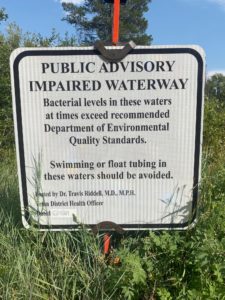Local Waterways Impaired by E. Coli

Wyoming Department of Environmental Quality has known for several years that Jackson’s Fish and Flat Creeks have, at times, contained more E. coli than is considered safe for swimming and other primary contact recreation.
E. coli are bacteria found in the environment, foods, and intestines of people and animals. Although most strains of E. coli are harmless, others can make you sick.
Fish Creek and portions of Flat Creek were listed as impaired waterways in January of 2020 due to elevated E. coli levels which are used as indicators of the presence of fecal material in the water. But, no action had been taken to warn users of the potentially harmful fecal bacteria.
In July of 2020, POWJH successfully petitioned the Teton District Board of Health to take action and install warning signs alerting float-tubers, swimmers, and anglers of potential health risks associated with in-stream recreation due to elevated E. coli levels. The signs were re-installed in the spring of 2021.
In 2021, a University of Wyoming research study will assess E. coli concentrations and sources. Knowing where E. coli comes from can help reduce levels in our drinking water, rivers, and streams. Some sources of fecal contamination include wildlife, pet waste, septic systems, wastewater treatment plants, and livestock manure. The results of the microbial source tracking study are expected to become available in 2022.
Kelsey Ruehling is a master’s student at the University of Wyoming studying zoology and physiology. She—along with fellow students Emma Román and Clara Bouley—is profiling microbial pollution in Teton County’s waterways.
“E. coli from wildlife is something we can’t control. I hope the community will talk more about the sources that we actually can control.”
Focusing on the sources we can control – such as pet and human waste – will help return drinking and recreational waters to acceptable levels. POWJH is involved in efforts that address these sources. Listen to this KHOL 89.1 FM broadcast to learn more:
